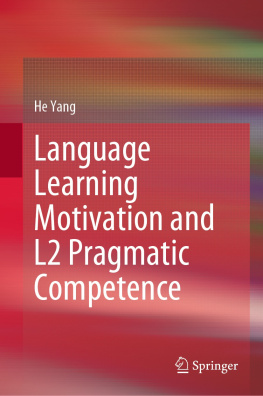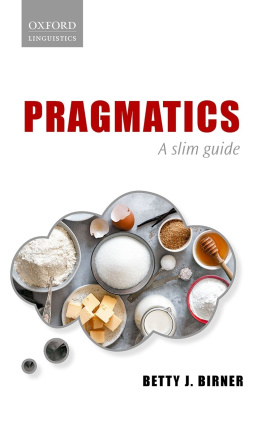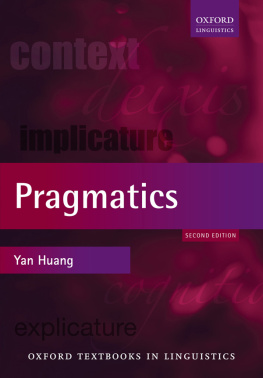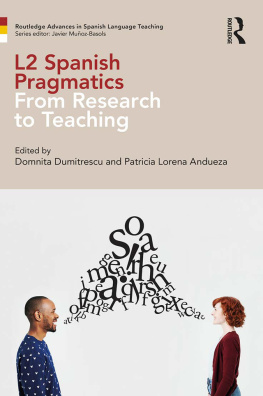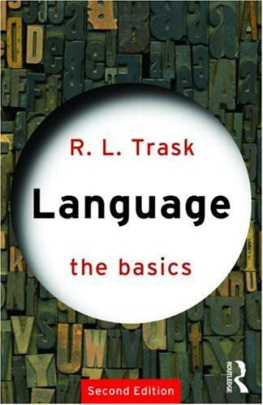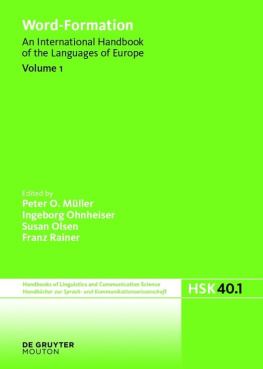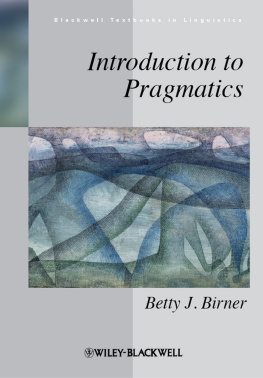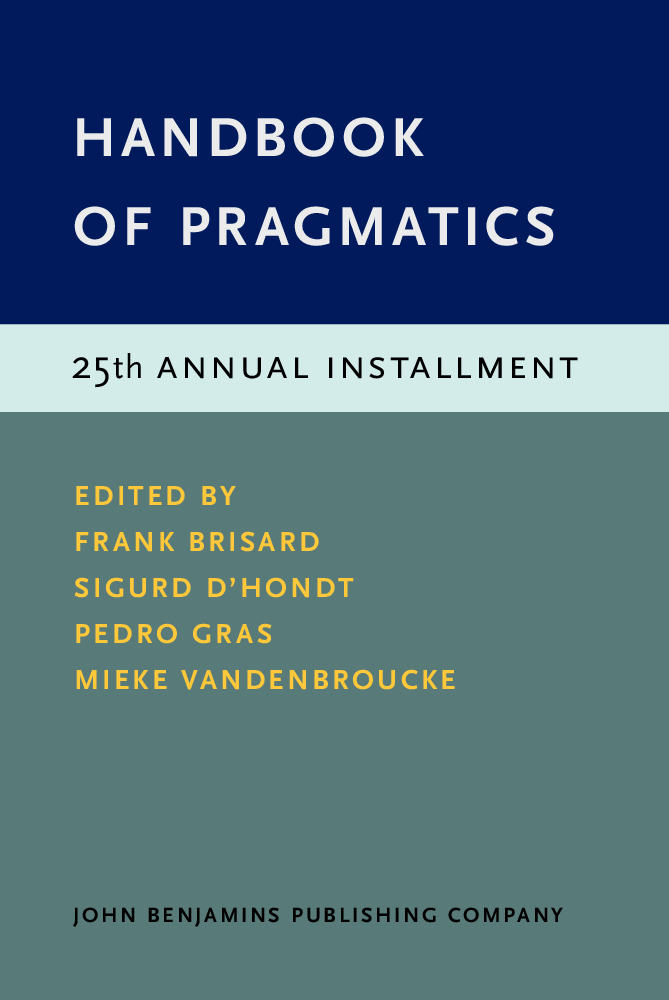Frank Brisard , Sigurd Dhondt , Pedro Gras & Mieke Vandenbroucke IPrA & University of Antwerp | IPrA & University of Jyvskyl
This years Annual Installment of the Handbook of Pragmatics, the 25th edition, brings you a new methods article on data management, specifically focusing on the technical and legal aspects of collecting multifunctional digital data (Joshua Wilbur and Michael Rieler). There is also a new addition to the traditions section: an introduction to Legitimation Code Theory, a relatively recent framework for analyzing knowledge practices, which has been applied to educational discursive uses (Erika Matruglio). In addition, a variety of pragmatic topics is dealt with: one discusses the notion of chronotope, a concept originating in narratology which has been applied to research on identities and digital communication (Anna De Fina); three others discuss speech acts that could be considered instances of trouble-talk, namely complaining (Andrea Rodrguez), swearing (Kristy Beers Fgersten and Karyn Stapleton), and teasing (Valeria Sinkeviciute); there are three more articles dealing with macrosocial aspects of language use, one on globalization (Lionel Wee), one addressing research on power and control (Luisa Martn Rojo), and one on youth language (Janus Spindler Mller, Andreas Candefors Sthr, and Marie Maegaard). And finally, we have a contribution on the use of language in the workplace (Janet Holmes, Bernadette Vine, and Meredith Marra).
On a different note, this installment of the Handbook of Pragmatics is the first prepared by a new editorial team. Jan-Ola stman and Jef Verschueren have handed over this task after more than 20 years, and we as editors are both proud to be able to take on this responsibility and thankful to the former editors for being invited to do so. We hope we will be able to match and thereby continue the high level of quality brought by Jan-Ola and Jef. For readers less familiar with the Handbook, a few words about its history and development may be useful.
When Jan-Ola stman and Jef Verschueren launched the idea of a Handbook of Pragmatics under the auspices of the International Pragmatics Association (IPrA; https://pragmatics.international ) in the early 1990s, they wanted to create a format that would be endlessly moldable for and by the readership. The very essence of scientific research is that scientific insights are dynamic, guided by uncertainty. In a field like pragmatics, with the functioning and use of constantly changing styles and registers of language as its focus of research, they did not want to produce a single book as the ultimate handbook of pragmatics. Since they saw this venture as a task that would take decades, if they wanted to do it properly, what they did not want either was to start with categories and traditions beginning with A and after a couple of decades finally reaching Z.
At that time, Jan-Ola and Jef settled for a loose-leaf publication format, relatively unorthodox in the humanities and social sciences. The idea was that this would enable the editors to gradually build up a changeable and expandable knowledge base for the users of the Handbook. Moreover, each individual reader would be able to group and re-group the entries according to their own preferences and particular interests, which no doubt would themselves be changing over time. So, with every three or four annual installments of the Handbook, the subscriber received a new ring binder in which to collect and order the new entries. The series of loose-leaf installments was preceded in 1995 by a hardback bound Manual, which provided background information on a wide range of traditions and research methods underlying much of the pragmatic research described in the more topical entries of the annual installments. Needless to say, this background information has evolved as well and has necessitated numerous new entries on traditions and methods in the loose-leaf installments. So far, 23 installments of the Handbook of some 300 pages each have been published, in addition to the 658-page Manual. Subscribers to the printed version of the Handbook of Pragmatics should have a bookshelf filled with the Manual plus 7 ring binders.
Meanwhile, the world has gradually become more and more digital. In the early 1990s hardly anyone could have foreseen the radical changes that have come to take place on the publishing scene. The Handbook of Pragmatics quickly followed suite, went online, and is available for readers as, precisely, the Handbook of Pragmatics Online ( https://benjamins.com/online/hop/ ). The online version has been continuously updated with new materials whenever and as soon as a new installment of the Handbook was published; and in cases where an entry has been totally rewritten, the older version has been retained in the Archive all in the interest of giving readers a feeling of how the discipline itself has changed and evolved over the decades.
Meanwhile, the online version has become the most often used version of the Handbook, both by individual scholars (especially by members of the International Pragmatics Association) and by many of the institutions and universities they are affiliated with. The loose-leaf version on paper was seldom subscribed to by individuals, but we are happy to say that it did attract the interest of university libraries and research groups. It is, however, challenging for libraries to make loose-leaf versions of books available for the general readership in a shape where all leaves/pages are physically a-loose.
Faced with this situation, Jan-Ola and Jef decided in close concertation with John Benjamins Publishing Company to produce further installments of the Handbook of Pragmatics, from the 21st onwards, in the form of bound volumes, of which the one you are now holding in your hands is the fifth. We are convinced that this makes the Handbook easier to handle and more attractive not only for libraries, but also for individual scholars who cherish the sensation and satisfaction of perusing a physical book. Meanwhile, the online version continues to integrate all additions and changes.
The gist of the Users Guide for the Handbook of Pragmatics and its online version largely remains the same as before see below. As in the loose-leaf version, we have a cumulative index (at the end of each volume), covering not only the present installment, but linking it to the entire Handbook of Pragmatics.
Acknowledgments
A project of this type cannot be successfully started, let alone completed, without the help of dozens, or even hundreds, of scholars. First of all, there are the authors themselves, who have sometimes had to work under harsh conditions of time pressure. Further, members of the IPrA Consultation Board have occasionally, and some repeatedly, been called upon to review contributions. Countless other colleagues, too many to list, have provided essential input as well by reviewing manuscripts.
The former editors (as well as the present ones) want to make sure that the contribution made by the co-editors of the Manual and the first eight annual installments of the Handbook is not forgotten: Jan Blommaert and Chris Bulcaen were central to the realization of this project. Similarly, Eline Versluys acted as editorial assistant for a five-year period ending in 2009. Our sincerest thanks to all of them.


